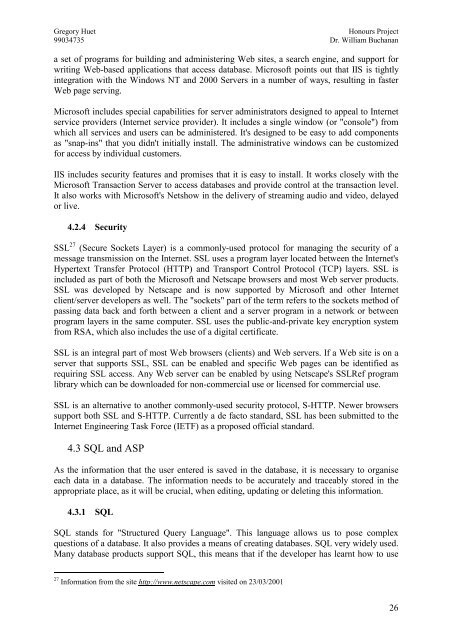Honours Project: - Napier University
Honours Project: - Napier University
Honours Project: - Napier University
You also want an ePaper? Increase the reach of your titles
YUMPU automatically turns print PDFs into web optimized ePapers that Google loves.
Gregory Huet<br />
<strong>Honours</strong> <strong>Project</strong><br />
99034735 Dr. William Buchanan<br />
a set of programs for building and administering Web sites, a search engine, and support for<br />
writing Web-based applications that access database. Microsoft points out that IIS is tightly<br />
integration with the Windows NT and 2000 Servers in a number of ways, resulting in faster<br />
Web page serving.<br />
Microsoft includes special capabilities for server administrators designed to appeal to Internet<br />
service providers (Internet service provider). It includes a single window (or "console") from<br />
which all services and users can be administered. It's designed to be easy to add components<br />
as "snap-ins" that you didn't initially install. The administrative windows can be customized<br />
for access by individual customers.<br />
IIS includes security features and promises that it is easy to install. It works closely with the<br />
Microsoft Transaction Server to access databases and provide control at the transaction level.<br />
It also works with Microsoft's Netshow in the delivery of streaming audio and video, delayed<br />
or live.<br />
4.2.4 Security<br />
SSL 27 (Secure Sockets Layer) is a commonly-used protocol for managing the security of a<br />
message transmission on the Internet. SSL uses a program layer located between the Internet's<br />
Hypertext Transfer Protocol (HTTP) and Transport Control Protocol (TCP) layers. SSL is<br />
included as part of both the Microsoft and Netscape browsers and most Web server products.<br />
SSL was developed by Netscape and is now supported by Microsoft and other Internet<br />
client/server developers as well. The "sockets" part of the term refers to the sockets method of<br />
passing data back and forth between a client and a server program in a network or between<br />
program layers in the same computer. SSL uses the public-and-private key encryption system<br />
from RSA, which also includes the use of a digital certificate.<br />
SSL is an integral part of most Web browsers (clients) and Web servers. If a Web site is on a<br />
server that supports SSL, SSL can be enabled and specific Web pages can be identified as<br />
requiring SSL access. Any Web server can be enabled by using Netscape's SSLRef program<br />
library which can be downloaded for non-commercial use or licensed for commercial use.<br />
SSL is an alternative to another commonly-used security protocol, S-HTTP. Newer browsers<br />
support both SSL and S-HTTP. Currently a de facto standard, SSL has been submitted to the<br />
Internet Engineering Task Force (IETF) as a proposed official standard.<br />
4.3 SQL and ASP<br />
As the information that the user entered is saved in the database, it is necessary to organise<br />
each data in a database. The information needs to be accurately and traceably stored in the<br />
appropriate place, as it will be crucial, when editing, updating or deleting this information.<br />
4.3.1 SQL<br />
SQL stands for "Structured Query Language". This language allows us to pose complex<br />
questions of a database. It also provides a means of creating databases. SQL very widely used.<br />
Many database products support SQL, this means that if the developer has learnt how to use<br />
27 Information from the site http://www.netscape.com visited on 23/03/2001<br />
26










![Unit 5. Switches and VLANs [PDF]](https://img.yumpu.com/34422504/1/184x260/unit-5-switches-and-vlans-pdf.jpg?quality=85)





